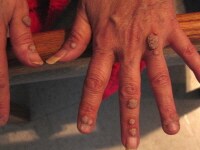
In a nutshell, herpetic whitlow is an injury or infection in a finger or thumb, which is due to the herpes simplex virus (HSV). This virus is mainly two types of HSV-1 and HSV-2. HSV 1 is more common affecting almost 60% of the people affected by herpetic whitlow. The remaining 40% of the affected people are infected by the HSV 2 virus. HSV-1 virus affects both children and adults alike. Among adults, this virus is usually contracted by health workers, dental assistants and other doctors who are exposed to oral secretions of sick people. Children infected with this virus usually those who have the habit to suck their fingers or thumb. Finger sucking or thumb sucking by the kids when they have oral sores gives them the infection. Adults, who are not in the medical field and in the age group of 20 to 50 contract HSV 2 virus when they come in direct contact with infected genitals.
Like other viral and bacterial skin infections, infections caused by herpes simplex virus are highly contagious. Herpetic whitlow is transmitted when a non-infected person comes in direct contact with infected skin lesions. This infection can appear as small blisters or sores in the mouth, nose, genitals or just any other part of the skin which was directly in physical contact with the infected area. HSV is easily transmitted by skin to skin contact with someone who is infected with herpes simplex virus. So if you have a wound, torn skin or broken skin and this part comes in direct contact with HSV blister of another person, the virus spreads from the wound and causes the infection. This is called auto-inoculation. In children and in health care workers, the spread of herpetic whitlow is largely attributed to self-inoculation or auto-inoculation of HSV-1.
No comments:
Post a Comment